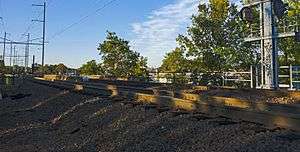Woodbridge train derailment
 Accident site in 2016 | |
| Date | February 6, 1951 |
|---|---|
| Time | 5.43 pm |
| Location | Woodbridge, New Jersey |
| Country | United States |
| Rail line | North Jersey Coast Line |
| Operator | Pennsylvania Railroad |
| Type of incident | Derailment at diversion |
| Cause | Excessive speed |
| Statistics | |
| Trains | 1 |
| Deaths | 85 |
| Injuries | 500 |
The Woodbridge train derailment occurred on February 6, 1951 in Woodbridge, New Jersey, when a train derailed crossing a temporary wooden trestle, killing 86 people. In addition to being the deadliest train wreck in New Jersey, it is not only among one of the worst train disasters in American history, but also the deadliest rail disaster in United States during peacetime.
Background
Train 733
Around 5 p.m. on February 6, 1951, Pennsylvania Railroad train 733 left Exchange Place in Jersey City. It provided express service to Bay Head via the North Jersey Coast Line. Train 733 was crowded that day due to a strike on the nearby Jersey Central Railroad and carried over 1,000 passengers.[1] in 11 cars carried by PRR K4s 4-6-2 steam locomotive 2445.[2]
Speed restriction
A temporary wooden trestle and a shoofly close by Fulton Street in Woodbridge had come into use around 1 p.m. that afternoon so that laborers building the New Jersey Turnpike could work on the main line. Eight days previously train engineers had been told to slow to 25 mph (40 km/h) through Woodbridge rather than the normal 60 mph (97 km/h) from 1:01 pm on Feb 6.[3] However it appears that despite being reminded of the restriction by his conductor prior to leaving Jersey City the engineer Joseph Fitzsimmons failed to slow the train and a subsequent inquiry found that it had been travelling at over 50 mph (80 km/h) when it hit the curve approaching the trestle. About a mile before Woodbridge the conductor, alarmed at the train's speed, had tried to pull the emergency cord but the crush of passengers made it impossible.[3]
Derailment
The overwhelming mass of the locomotive shifted the tracks, causing the derailment; and eight of the eleven cars derailed; the first two cars just fell on their side but the third and fourth cars crashed into each other as they hurled down a 26-foot-high (7.9 m) embankment.[4] It was in these two cars that most of the 85 fatalities occurred. The fifth and sixth cars were left hanging in mid-air over a street which was noticeably glistening from rain, and some say that many who survived the crash jumped to their deaths believing they would land in water, although the street was at a considerable distance away from them.[5] The accident happened at 5:43 p.m. in a heavily populated area, so help soon arrived, and neighbors opening their houses to those in need. The critically injured were taken to the hospital.
The crash was the deadliest railroad derailment in the United States since 1918.[6]
Inquiry
Although it was claimed by the engineer that he had been travelling at only 25 mph (40 km/h), the inquiry cited the cause as "intense speed on a curve of a temporary track", estimating that the speed was between 50 and 60 mph (80 and 97 km/h). Fitzsimmons continued working for the railroad, but never operated a train again. [1]
See also
- List of American railroad accidents
- List of rail accidents (1950–59)
- Slapstick (novel), a novel by Kurt Vonnegut; the wreck is referenced in the novel as the cause of death of his brother-in-law two days before his sister's death from cancer, leaving their four children suddenly orphaned
References
- 1 2 https://web.archive.org/web/20080725001302/http://www.woodbridgefdnj.org/History/Wreck/SL/sl.htm. Archived from the original on July 25, 2008. Retrieved June 11, 2010. Missing or empty
|title=(help) - ↑ "Locomotive image". Angelfire.com. Retrieved 2014-02-05.
- 1 2 https://web.archive.org/web/20080725001358/http://www.woodbridgefdnj.org/History/Wreck/THNT/thnt3.htm. Archived from the original on July 25, 2008. Retrieved June 11, 2010. Missing or empty
|title=(help) - ↑
- ↑ "SPAN JUST OPENED; SCENES OF FATAL TRAIN WRECK WHICH TOOK HEAVY TOLL". The New York Times. February 7, 1951. Retrieved September 18, 2018.
- ↑ "THE NATION; Disaster at Woodbridge Worst Since 1918 The Whys 18-Year-Olds--Maybe What Fiscal Policy? Federal Reserve Issue The Arguments R.F.C. Under Fire Mr. Truman's Reaction Remington: Guilty Defense Testimony". The New York Times. February 11, 1951. Retrieved September 18, 2018.
External links
- Color photo of the scene the day after the accident
- The Woodbridge Train Wreck
- ICC Report, Transcription available via DOT library